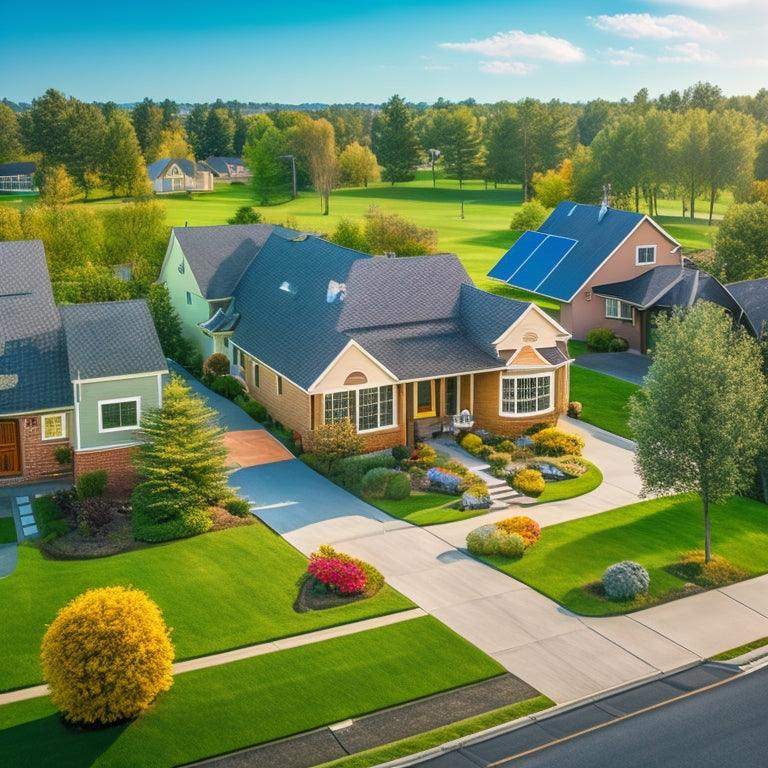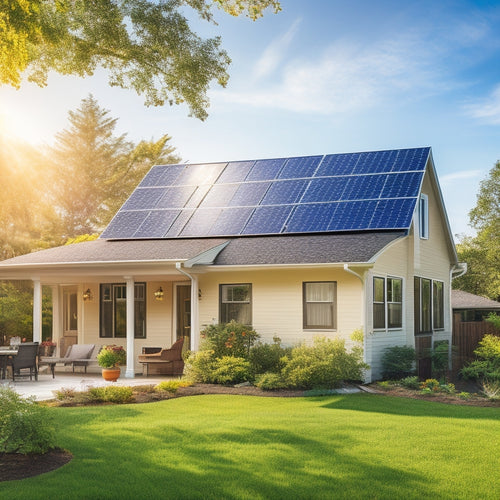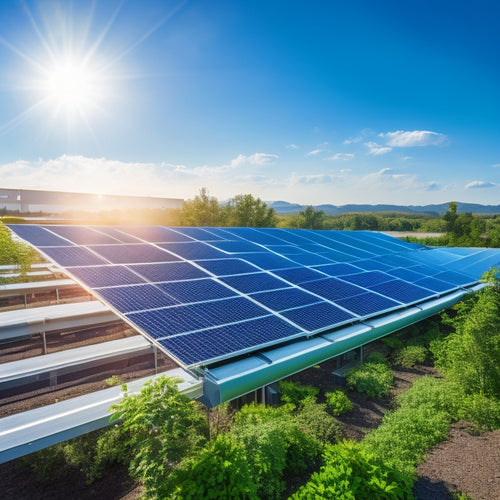
What Are the Top 10 Residential Solar Panel Cost Savings Strategies
Share
You can greatly reduce your solar panel installation costs by employing various cost-savings strategies. Take advantage of tax credits and incentives, which can save you up to 26% of the total system cost. Opt for manufacturer discounts, financing options, and cost-effective installation strategies like DIY installation and labor cost savings. Maximizing solar panel efficiency through optimizers, routine maintenance, and long-term planning can also lead to substantial savings. Additionally, investigate alternative panel options, energy management and usage optimization, community solar programs, and negotiation with solar providers to further reduce costs. And, by understanding these strategies, you'll be well on your way to minimizing your solar panel expenses.
Key Takeaways
- Take advantage of tax credits and incentives, including federal and state rebates, energy credits, and Renewable Energy Certificates (RECs).
- Maximize solar panel efficiency with optimizers, routine maintenance, and long-term planning to increase energy harvesting and reduce system losses.
- Consider cost-effective installation strategies, such as DIY installation, labor-saving techniques, and negotiating with contractors to reduce installation fees.
- Optimize energy usage and management by monitoring consumption, conducting energy audits, and implementing energy-efficient appliances to reduce overall usage.
- Explore alternative panel options, including thinner solar panels and used or refurbished panels, to reduce upfront costs without sacrificing performance.
Take Advantage of Tax Credits
Take Advantage of Tax Credits
One of the most notable benefits of investing in solar panels is the opportunity to take advantage of tax credits. When you install solar panels, you're eligible for federal incentives that can considerably reduce your tax liability. You can claim a tax credit of up to 26% of the total cost of your solar panel system, which can be a substantial savings.
Additionally, many states offer rebates and tax deductions that can further reduce your costs.
Beyond federal incentives, you may also be able to take advantage of energy credits, which can provide additional savings. When you finance your solar panel system with a solar loan, you can also benefit from financial planning strategies that maximize your investment returns.
By depreciating your solar panel system, you can claim depreciation savings, which can further reduce your tax liability. By utilizing these credits and incentives, you can optimize your credit utilization and minimize your tax burden.
With careful planning, you can maximize the regulatory benefits of going solar and enjoy notable cost savings.
Increase Efficiency With Optimizers
You can greatly enhance your solar panel system's performance by incorporating optimizers, which enable you to maximize energy harvesting by ensuring each panel operates at its peak potential.
Optimizers also help reduce system losses, such as mismatch losses and shading losses, that can occur when panels are connected in a string.
Maximize Energy Harvesting
By installing optimizers, homeowners can squeeze every last watt out of their solar panels, maximizing energy harvesting and thereby reducing their reliance on the grid.
To achieve this, it's crucial to evaluate several factors that impact energy production. Conducting a shading analysis helps identify areas where trees or structures cast shadows on your roof, allowing you to strategically place panels for peak energy harvesting.
Correct roof orientation and panel placement also play a significant role in maximizing energy output. Inverter selection is critical, as it guarantees that your system can handle the maximum power output of your panels.
Proper system sizing and grid connection are also important to confirm that your system can handle your energy consumption needs. Additionally, evaluate the climate impact on your system's performance and schedule regular maintenance to guarantee peak operation.
Reduce System Losses
System losses can silently erode the efficiency of your solar panel installation, diminishing the return on your investment. You can reduce these losses by optimizing your system's performance through advanced energy management strategies.
Performance monitoring and inverter selection are essential in identifying areas of inefficiency. Conducting a shading analysis can help you determine the best installation orientation to minimize energy losses. Weather considerations, such as temperature and humidity, also play a significant role in system performance.
By implementing effective maintenance practices, you can guarantee your system operates at peak efficiency. In addition, grid integration and energy efficiency can be improved through the use of optimizers, which can increase energy production by up to 25%.
Opt for Thinner Solar Panels
You can reduce your solar panel costs by opting for thinner panels, which use less material and result in lower production costs.
These slim designs not only save on materials but also enable more efficient manufacturing processes.
Less Material Used Here
Thinner solar panels require fewer materials, which translates to significant cost savings. When you opt for thinner solar panels, you're fundamentally reducing the material requirements for your solar panel installation. This material efficiency directly impacts your bottom line, as you'll need less raw material to generate the same amount of power.
Resource optimization is key in this strategy. By using thinner solar panels, you're able to conserve resources, reduce waste, and minimize the environmental impact of your solar panel installation. This approach also leads to a more streamlined manufacturing process, which can further drive down costs.
You'll notice that thinner solar panels don't compromise on performance. They're designed to provide ideal energy output while reducing material usage. This means you can enjoy the same level of power generation while keeping costs in check.
With thinner solar panels, you're getting more bang for your buck – and that's a winning strategy for anyone looking to maximize their solar panel investment.
Reduced Production Costs Now
Reduced Production Costs Now
Manufacturers benefit from reduced production costs when opting for thinner solar panels. You can take advantage of this cost-saving strategy by choosing panels made with alternative materials or using bulk purchasing to negotiate better prices.
Thinner solar panels require less material, resulting in lower production costs. This reduction in material usage also leads to decreased waste and environmental impact.
When you opt for thinner solar panels, you can expect to see significant cost savings without compromising on performance. In fact, many thinner solar panels are designed to be more efficient, allowing you to generate more power with less material.
Slimmer Designs Save
Slimmer Designs Save
Manufacturers' efforts to slim down solar panels have led to a significant reduction in production costs, making it possible for consumers to benefit from this cost-effective solution.
You'll find that thinner solar panels not only reduce material usage but also enhance their overall aesthetic appeal. They're designed to be more compact, allowing for a sleeker installation that blends seamlessly with your roof's design.
Thinner solar panels also offer increased installation flexibility. You can now install them on roofs with limited space or unique angles, making it easier to generate power in areas that were previously unsuitable.
Additionally, the reduced weight of these panels simplifies the installation process, reducing labor costs and time. With slimmer designs, you can enjoy a more efficient and cost-effective solar panel system that still provides the same level of power output.
Consider Used or Refurbished Panels
Opting for used or refurbished solar panels can be a savvy move for those looking to install a solar panel system on a budget. You'll find that used panels can offer significant cost savings, often up to 50% off the price of new panels.
However, it's crucial to weigh the pros and cons before making a decision. Used panels may have reduced panel longevity, and their performance degradation might be more significant than new panels. Additionally, installation warranties may not be transferable, and maintenance costs might be higher.
On the other hand, refurbished panels can offer a good balance between cost and performance. They've been inspected, repaired, and tested to meet manufacturer standards, guaranteeing they still provide reliable energy independence and grid independence.
Refurbished panels also have a lower environmental impact, as they reduce electronic waste. In addition, they can still qualify for energy credits, and their resale value is higher than that of used panels.
When considering used or refurbished panels, prioritize their performance, warranty, and maintenance costs to make sure you're making an informed decision that aligns with your energy goals.
DIY Installation and Maintenance
You can save a significant amount of money on your solar panel system by installing it yourself, which eliminates labor costs.
Additionally, you'll reduce installation fees by taking on this task, allowing you to allocate those funds to other aspects of your project.
Save on Labor Costs
Installing solar panels can be a significant investment, but one major area where homeowners can cut costs is on labor. By implementing labor-saving techniques, you can reduce the overall cost of your solar panel installation.
One approach is to contemplate DIY installation and maintenance. While this may require some technical proficiency, it can save you thousands of dollars in labor costs. However, if you're not comfortable with DIY installation, you can still negotiate with contractors to get a better deal.
You can ask potential contractors about their labor saving techniques and how they plan to minimize labor costs. Additionally, be sure to get quotes from multiple contractors and compare their prices to find the best deal.
Effective contractor negotiations can result in significant cost savings. By combining DIY elements with smart contractor negotiations, you can optimize your labor costs and maximize your return on investment.
Reduce Installation Fees
Reduce Installation Fees
Technical knowledge plays an essential role in reducing installation fees through DIY installation and maintenance. You can save thousands of dollars by taking on some or all of the installation tasks yourself. However, this approach requires a good understanding of installation techniques, local building codes, and electrical systems.
You'll need to research and perfect the skills necessary to guarantee a safe and efficient installation.
When you choose to DIY, you'll need to select the right equipment and materials for your solar panel system. Be careful when selecting a contractor for any aspects of the installation you can't handle yourself.
Research and vet potential contractors thoroughly to confirm they've the necessary experience and certifications. A good contractor selection process can help you avoid costly mistakes and assure a successful installation.
Perform Routine Checks
Regularly inspecting your solar panel system helps identify potential issues before they escalate into costly problems, guaranteeing ideal energy output and prolonging the system's lifespan.
By performing routine checks, you can detect minor issues before they affect panel longevity. This proactive approach involves routine maintenance, which includes performance monitoring and system diagnostics. You'll be able to assess wear and tear on your system, identifying areas that need attention.
Create a cleaning schedule to guarantee your panels remain free from debris, which can reduce energy output. A well-maintained system will optimize energy production, saving you money on your electricity bills.
Additionally, routine checks can help you identify potential issues with your system's inverters, wiring, or mounting structures. By addressing these problems early, you'll avoid costly repairs and replacements.
Look for Manufacturer Discounts
Look for Manufacturer Discounts
Several top-tier solar panel manufacturers offer discounts on their products, which can greatly reduce your upfront costs. By taking advantage of these discounts, you can save thousands of dollars on your solar panel installation. You can find these discounts through manufacturer partnerships, promotional events, and special offers.
Here is an example of some manufacturer discounts:
| Manufacturer | Discount |
|---|---|
| Tesla | 10% off all solar panels |
| SunPower | $500 off all residential installations |
| Panasonic | Buy one panel, get one free |
When shopping for solar panels, be sure to research and compare prices from different manufacturers to find the best deals. Additionally, look for bundle discounts, where you can save even more by purchasing multiple products from the same manufacturer. By taking advantage of these discounts, you can considerably reduce your solar panel costs and start generating clean energy for your home sooner.
Reduce Costs With Energy Storage
As you investigate ways to minimize your solar panel costs, considering energy storage can be a pivotal moment. By integrating energy storage into your solar panel system, you can achieve energy independence and reduce your reliance on the grid. This means you can store excess energy generated during the day for use during peak demand periods, reducing your energy bills.
A battery's lifespan is typically around 10-15 years, making it a worthwhile investment for long-term cost savings.
Load shifting is another key benefit of energy storage. By storing energy during off-peak hours and using it during peak hours, you can avoid high demand charges. Additionally, many utilities offer renewable incentives for homes with energy storage systems, providing an added cost benefit.
Smart technology enables seamless grid integration, ensuring a smooth shift between your solar panel system and the grid. With energy storage, you'll also enjoy enhanced energy resilience, reducing your vulnerability to power outages.
Negotiate With Solar Providers
Most solar panel installations require a significant upfront investment, but savvy homeowners can negotiate with solar providers to reduce their costs substantially.
You can do this by comparing quotes from different providers and identifying areas where you can negotiate better contract terms. Research the market rates for solar panel installations and make a list of the providers that offer the best deals.
When negotiating with a provider, focus on the total cost of ownership, including the installation cost, maintenance fees, and the cost of repairs.
Ask about any additional costs, such as permit fees, inspection fees, and connection fees. Compare the contract terms offered by different providers, and look for the one that offers the best warranty and performance guarantees.
Use Solar Panel Financing Options
You've successfully negotiated with solar providers and secured a better deal, but you still need to contemplate how to finance your solar panel installation.
Fortunately, there are various solar panel financing options available to help make your renewable energy dream a reality. Solar loans and leasing options are popular choices, offering flexible payment plans that cater to different budget considerations.
When exploring these options, be mindful of interest rates, as they can greatly impact your long-term savings. A good credit score can help you secure more favorable interest rates, so it's crucial to check your credit report before applying for financing.
The financing benefits of solar panels extend beyond the initial installation costs, as they can increase your property value and provide considerable financial incentives through tax credits and rebates.
Monitor and Adjust Energy Usage
Your newly installed solar panels are generating clean energy, but to maximize your solar panel cost savings, it's essential to monitor and adjust your energy usage. By integrating a smart home energy monitoring system, you'll gain important revelations into your consumption patterns and usage analytics.
This real-time feedback allows you to identify areas for improvement and make adjustments to optimize your energy usage. Automated adjustments can be made to reduce energy consumption during peak hours, and efficiency tracking helps you stay on top of your progress.
By making behavioral changes based on your usage data, you can greatly reduce your energy bills. For instance, you might adjust your laundry schedule or alter your lighting habits to minimize energy waste.
With usage optimization, you can guarantee that your solar panels are generating the most energy possible, reducing your reliance on the grid and maximizing your cost savings. By taking control of your energy usage, you'll be able to reveal the full potential of your solar panel system and enjoy considerable savings on your energy bills.
Frequently Asked Questions
Can I Install Solar Panels on a Rented Property?
You can't directly install solar panels on a rented property, but you can investigate solar leasing options or look for renter incentives offered by some states or utilities, allowing you to benefit from solar energy without ownership.
How Do I Ensure My Solar Panels Are Protected From Hail?
Imagine your solar panels shattered by hail - a nightmare! To avoid hail damage, you'll want to guarantee your panels are built with durability in mind, featuring tempered glass and sturdy frames that can withstand harsh weather conditions.
Do Solar Panels Work During a Power Outage?
You'll be glad to know that, during a power outage, your solar panels still generate electricity, but you won't be able to use it unless you have a battery backup system or a grid-tie inverter with power outage solutions, which can optimize solar panel efficiency.
Can I Use Solar Panels to Charge My Electric Vehicle?
Did you know 80% of EV owners charge at home? You can use solar panels to charge your electric vehicle, leveraging solar incentives to offset costs. Optimize charging efficiency by pairing your solar system with a level 2 charger for a seamless, emissions-free ride.
Are Solar Panels Resistant to Saltwater Corrosion?
When you install solar panels in coastal areas, you'll want to guarantee they're resistant to saltwater corrosion. You'll need to prioritize solar panel maintenance, such as regular cleaning and inspections, to prevent damage from saltwater exposure in coastal installations.
Conclusion
By implementing these top 10 residential solar panel cost savings strategies, you'll maximize your return on investment. You'll optimize your system's performance, reduce upfront costs, and minimize long-term expenses. You'll take advantage of tax credits, increase efficiency, and opt for cost-effective solutions. You'll negotiate with providers, finance wisely, and monitor your energy usage. By doing so, you'll unleash the full potential of solar energy, saving you money and reducing your carbon footprint in the process.
Related Posts
-

How to Finance Home Solar Panels
Financing home solar panels offers several strategies to lighten your initial costs while maximizing long-term benefi...
-

Sustainable Home Design for Reduced Carbon Footprint
Sustainable home design is your pathway to a smaller carbon footprint and a healthier living space. By incorporating ...
-

Solar Energy Efficiency Improvements for Businesses
Improving solar energy efficiency for your business can lead to considerable cost savings and enhance your sustainabi...


